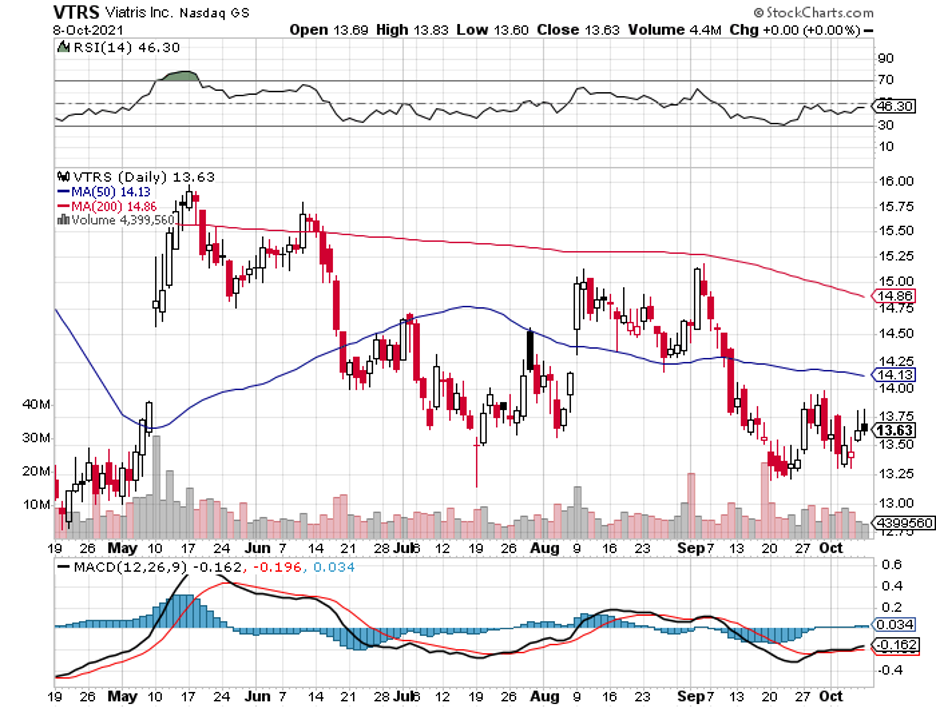Some stocks bring red-hot gains. These companies are thrilling. Most investors flock to these businesses like bees to honey. Then, there are stocks such as Viatris (VTRS).
You won’t hear much buzz about Viatris.
After all, this company develops generic drugs—a fairly boring business. At times, it feels like nobody even talks about this stock at all.
However, Wall Street claims that several stocks have more room to expand soon. Interestingly, the names aren’t your usual list of growth stocks that most investors expect to ascend. The largest expected gainers are boring stocks.
This is where Viatris becomes interesting.
One of the possible reasons that Viatris isn’t generating as much buzz is that it was only established in 2020. The company is the product of a spinoff between Pfizer’s (PFE) Upjohn unit and generic drugmaker Mylan.
The spinoff allowed Pfizer to concentrate more on developing its pipeline candidates, while Viatris focused on off-patent and generic drugs.
However, Viatris has been off to a slow start, with the stock down by over 28% this year. In fact, the company has reported net losses for three quarters in a row.
Needless to say, both resulted in having the stock deeply discounted.
While these can cause other investors to shy away from the stock, I look at it as part of the company’s growing pains.
And it looks like things are about to turn around soon.
By the end of this year, Viatris expects to reach cost synergies of roughly $500 million. Through major restructuring, the company anticipates doubling this to more than $1 billion by 2023.
As an early-stage business, Viatris offers a stable long-term investment.
While it recorded a somewhat flat performance at $4.6 billion in sales in June, the company’s lineup of new products signals growth ahead.
For example, Viatris estimates to generate roughly $690 million in revenue for its new products—a highly achievable projection for the company.
Just last July, Viatris scored approval for a biosimilar product called Semglee. This is an insulin biosimilar to the high-selling Lantus of Sanofi (SNY), which peaked at $6.4 billion in sales in 2015 and lost patent exclusivity in 2014.
Semglee is reported to be fully interchangeable with the reference drug, which means that Viatris’ biosimilar is the exact equal of Sanofi’s previous blockbuster.
Moreover, Semglee is priced at about $148 for five pre-filled insulin pens, offering a whopping 65% reduction from Lantus’ cost.
The significant price difference is clearly difficult to ignore, especially at a time when politics has joined the fray in drug pricing.
The ability of Viatris to undercut the prices offered by Big Pharma definitely signals long-term benefits in terms of the company’s bottom line.
Aside from Semglee, Viatris has seven more approved biosimilars on the market.
The list includes Roche’s (RHHBY) breast cancer treatment Herceptin, which peaked at $6 billion in sales, and Regeneron’s (REGN) AMD drug Eylea, which generates an average of $8 billion annually.
It even has AbbVie’s (ABBV) megablockbuster immunology therapy Humira, which averages $20 billion in sales annually.
While Viatris won’t be the only company marketing a biosimilar for Humira, the company has the advantage since its candidate, Hulio, already gained approval in Canada, Europe, and even Japan.
Meanwhile, Viatris’ near-term pipeline candidates hold the potential to generate $57 billion in sales. Adding the rest of its 31 biosimilar candidates could push the figure to $224 billion.
The expansion of the biologics market is anticipated to outpace traditional pharma in the future. From $300 billion in 2020, the biologics segment is projected to reach $690 billion by 2027.
Aside from its biosimilar programs, Viatris has also been working on its internal development plans.
This would mean developing new high-margin brand names as well as diversifying its portfolio to include novel therapies.
Viatris is projected to reach at least $35 per share in the coming months, showing off a promising 155% jump from its current price.
On top of that, investors have been enjoying a juicy payout of 3.2%—higher than the average 1.3% of the S&P 500.
Considering the risks brought by market correction, Viatris emerges as a prime candidate for a safe haven among investors.
That is, they can easily lock in on this relatively anti-bubble business that’s available at practically a bargain bin price.


